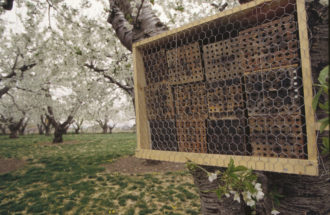With support from SARE, the Osmia Bee Company in Ohio is designing a seed mix to support springtime pollinators — particularly mason bees.
They developed a guide with the intention that the information could be used as a starting point and adapted for other field trials.
This project leverages the rich collaborative network maintained by the Osmia Bee Company and services provided by Penn State’s Honey and Pollen Diagnostics Laboratory to determine the variety and intensity of mason bee foraging on spring flowering plant genera found across Ohio State.
The primary objective of this project is to develop a spring flowering herbaceous seed mix to support mason bees in the North Central region. A secondary objective is to provide mason bee producers and conservationists with a detailed list of local plants that support the reproduction of springtime bees, especially the native blue orchard bee.
"One success story comes from a study participant - a small orchardist in the Cincinnati area growing apple, tart cherry, plum, and peach," said Justina Block with Osmia Bee Company. "She has been using mason bees in her orchard for the last five years. Her honey bees the last four years have not survived the winter, and has had to purchase two hives each spring. With the addition of mason bees, she has seen a noticeable increase in her fruit yields. She loves the ease of working with the mason bees and non-aggressive nature. Because of this, she’s now considering using only the mason bees for pollination services on her farm."
URL: https://osmiabee.com/sare-project
Ordering Information
Justina Block
justina@osmiabee.com
Osmia Bee Company
https://osmiabee.com/
513-604-6997
Want more information? See the related SARE grant:
This material is based upon work that is supported by the National Institute of Food and Agriculture, U.S. Department of Agriculture through the Sustainable Agriculture Research and Education (SARE) program. Any opinions, findings, conclusions, or recommendations expressed in this publication are those of the author(s) and should not be construed to represent any official USDA or U.S. Government determination or policy.
